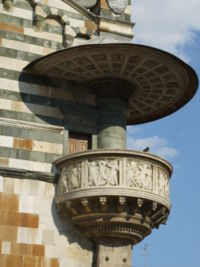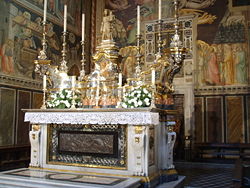- Prato Cathedral
-
Cathedral of Saint Stephen
(Cattedrale di Santo Stefano)
The facade of the Cathedral
Basic information Location Prato, Italy Affiliation Roman Catholic Province Prato The Cathedral of Prato (Italian: Duomo di Prato) is the main Catholic church of Prato, Tuscany, Central Italy and seat of the bishop. It is dedicated to St. Stephen, the first Christian martyr. It is one of the most ancient churches in the city, existing already in the 10th century and having been built and in several successive stages in the Romanesque style. The churches has a number of notable works of art, in particular, fine sculpture.
Contents
History
The Cathedral is documented as early as the 10th century as the Pieve of Santo Stefano, located in the Borgo al Cornio, the first settlement in Prato.
The current structure dates from Romanesque period of the 12th century, the nave, side walls and greater part of the bell tower remaining from this date. The upper stage of the bell tower was constructed in 1356.
During the 14th century, the Cathedral acquired an important relic, the Sacra Cintola or Belt of the Holy Virgin. This brought about the enlarging of the edifice by the addition of a transept which is attributed to Giovanni Pisano, but probably the work of a pupil of Nicola Pisano. The Cintola Chapel was also built at this time to house the relic.
In the early 15th century, a new façade was added in the International Gothic, in front of the old one. In the space between the two was created a narthex or corridor leading to the external pulpit, built by Michelozzo and decorated by Donatello between 1428 and 1438.
The facade is architecturally simple, the shape of the building informing the new structure so that its low-pitched central roof and sloping side aisles mark the roofline, which is enlivened with an open parapet of simple Gothic tracery, uniting the building with the sky. The facade is divided into three sections by shallow buttresses or pilasters. That part of the facade above the springing of the door arch is faced with marble in bold contrasting stripes, while the lower part is pale-coloured but much stained in some areas, possible from the absorption of pollutants.
The facade has a single central portal with a lintelled doorway surmounted by a Gothic arch. In the lunette over the door is a glazed terracotta sculpture by Andrea della Robbia depicting the Madonna with Saints Stephen and John.
Below the central gable, a decorative clock is set into the facade, in place of a central window. It is surrounded by segments of the contrasting marble and forms part of the harmonious design.
The frescoes of the transept chapel date from the same century as the facade, but are of the Renaissance painting style.
Interior
Internally, the church has a nave and aisles, all in Romanesque style and dating from the early 13th century. They are separated by elegant columns of green serpentine, the capitals being attributed to Guidetto. The vaults, designed by Ferdinando Tacca, were added in the 17th century.
The left aisle houses a notable Renaissance pulpit in white marble (1469-1473). The base is decorated with sphynxes. The parapet has reliefs by Antonio Rossellino, portraying the Assumption and the Histories of St. Stephen, and by Mino da Fiesole portraying the Histories of St. John the Baptist. It is faced, in the opposite aisle, by a great bronze candelabra by Maso di Bartolomeo (1440), having an elongated vase-shape from which seven branches protrude. Maso also executed the balcony of the inner west wall, which is also decorated with a fresco of the Assumption by David and Ridolfo del Ghirlandaio.
Transept
A small staircase leads from the old church to the 14th century transept, which has five high cross vaults, each ending in an apse divided by pilasters. The presbytery has three works by the American artist, Robert Morris (2000-2001).
In the transept right is the Renaissance tabernacle by the Da Maiano brothers: the Madonna with Child terracotta (1480) is by the more famous Benedetto.
The chapels can be accessed through a 17th century balustrade in polychrome marble, for which part of the Renaissance choir were re-used (including crests and cherubims).
Transept chapels
On the transept right, the Vinaccesi Chapel is home to a notable Deposition of Christ from the 13th century. It also has 19th century frescoes by the Pratese painter Alessandro Franchi.
Next is the Assumption Chapel, which was frescoed in 1435-1436 by the so-called Master of Prato and by a young Paolo Uccello, who painted the Histories of the Virgin and St. Stephen, completed by Andrea di Giusto in the lower section. They show a bizarre fantasy of enchanted figures caught in a wide range of brilliant colors, and surrounded by Brunelleschi-like architectures.
In the main chapel, or chancel, Filippo Lippi and Fra Diamante painted the Histories of St. Stephen and St. John. In the lower left wall are depicted the Obsequies of St. Stephen, in which, set in a Palaeo-Christian basilica, Lippi portrayed Pope Pius II as an imposing figure in scarlet costume. On the right is the artist's self-portrait. On the opposite wall is Herod's Banquet, showing a large hall in which Salome is performing her ballet, and the handing over of St. John's head to Herodias. The altar is by Ferdinando Tacca (1653).
The Manassei Chapel was frescoed by a pupil of Agnolo Gaddi in the early 15th century with Histories of St. Margaret and St. James. The last chapel on the left houses a funerary monument attributed to Benedetto da Maiano and a stained glass window from the early 16th century.
Cintola Chapel
The Cintola Chapel (Italian: Cappella del Sacro Cingolo) is located under the last arch of the left aisles, next to the counter-façade. It houses the Sacra Cintola, the belt which, according to the tradition, was given to St. Thomas by the Virgin Mary during the Assumption. It was brought to Prato in the 13th century.
The chapel has frescoes of Histories of the Virgin and the Cintola by Agnolo Gaddi (1392-1395), which are notable for their luminous colors. Also noteworthy is the panorama of Prato in the Michael's Return scene.
The 18th century altar, which encloses the Cintola, is crowned by a marble Madonna with Child (c. 1301), considered one of Giovanni Pisano's masterpieces.
External links
- Diocese of Prato - Cathedral page (Italian)
Coordinates: 43°52′55″N 11°05′52″E / 43.88194°N 11.09778°E
Categories:- Churches in Tuscany
- Romanesque architecture in Tuscany
- 12th-century architecture
- Cathedrals in Italy
- 10th-century church buildings
- Buildings and structures in Prato
Wikimedia Foundation. 2010.




